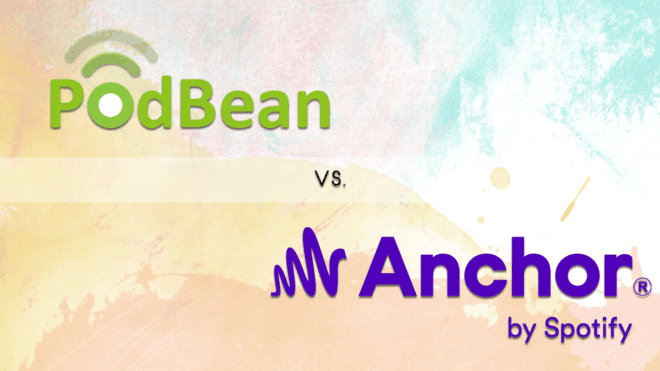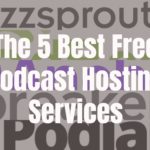Anchor vs. Podbean Podcast Host Review 2021

Last updated on March 15th, 2024
Podcasting, as an industry, continues its meteoric rise in 2021. Habits are tough to break and podcast consumption was one of America’s favorite new habits last year. Along with hand washing and amateur epidemiology.
Once down the rabbit hole, after podcast consumption is podcast creation. The types you can create are limitless and the barriers of entry are pretty low.
While you don’t need much, one of the first and most important is a reliable podcast host. The best host that gives you flexibility and encourages your creative endeavors. Well, and gets your creation into people’s earholes with minimal friction. That’s a big one.
We’re going to take at two major contenders and break down what makes each unique. Today, it’s Podbean vs. Anchor for the title of the best podcast host.
Podbean
If you’ve been around podcasting for any amount of time, you’ve heard the name Podbean. They’ve been at it since 2006, and in that entire time, their name has been near the top of everyone’s best of lists.
It’s not hard to see why. Their free plan is a nice offering.
Podbean Always Free
That free plan buys you 5 hours of audio storage along with 100GB of bandwidth each month. You get basic statistics on audience listenership and episode downloads. As well a free companion website that gives your podcast an accompanying blog.
This companion website might be Podbean’s killer app. Most people are multimodal learners. This means they learn by some combination of audio, visual, or written.
A companion blog with expanded commentary and show notes sets your show apart from the competition and does so seamlessly.
You don’t need to be any kind of techie to make any of Podbean’s services work for you either. Their podcaster first philosophy means they make the process transparent and get out of your way.
The basic plan also covers all of your distribution bases. Your show’s RSS feed is widely distributed to ensure listeners can find you on all major Android and iOS podcatchers. Your show will also be included in Podbean’s native apps as well.
Podbean Unlimited Audio: Unlimited Storage and Downloads, Plus Comprehensive Analytics and Customizable Monetization
While the free offering is nice, most hobbyists and beyond will want to look at their $9 a month plan. $9 a month is 30 cents a day… so, for all intents and purposes, that’s a very low bar.
Unlimited storage and bandwidth starts with the $9 plan. That’s true unlimited as well, so if an episode goes viral, you don’t have to worry about it costing you anything or going over budget. For someone with OCD about metered pay as you go versus unlimited, having unlimited available for $9 is a real comfort. I wouldn’t have thought you could put a price on peace of mind, but it turns out you can, and it’s nine bucks.
Bandwidth and storage just isn’t something I want to spend time worrying about. I want to focus on growing my show’s reach and getting it to make money.
When it comes to monetization and reach Podbean really shines. The $9 tier is where you get true unlimited creative control. You get access to “pro” themes, comprehensive listener statistics, a mappable custom domain for your show. And, this is a biggie, access to the advertising marketplace and their dynamic ad insertion tool called PodAds (to run your own ad campaigns). That whole bundle is unlocked at the $9 tier.
I actually had to double check that one twice. Four checks, because that’s just a tremendous value. All paid plans come with IAB-certified comprehensive statistics and Podbean offers easy-to-understand graphs that help you better analyze how your podcast is performing. Not only that, but Podbean also helps you tap into listener support to monetize. They have a built-in Patron program for ongoing listener support, where you can provide special Patrons-only content and you can also sell premium content directly through their app.
Podbean also has a $29 per month plan that is best for video podcasts. At that level you’re able to provide audio, written, and video content to your listeners that’s widely distributed and easily monetized.
New features, like Podbean Live and their Podbean app for recording on the go have only made the service richer. Adding new features onto an already robust podcaster only platform.
Podbean has sought to be an all-in-one solution for every level of podcaster, and they’ve adhered to that philosophy since 2006.
Anchor.fm
Anchor is all about being the free solution for podcasters of all walks. Create, distribute, and monetize for free. That’s the deal. Which is, pretty much true. Once Anchor.fm became Anchor.fm by Spotify’s acquisition in 2019, there were some concerns about what would happen to the service. Thus far it seems to be on the up and up.
There was a bit of uproar about who actually owned your content in early drafts of the Spotify TOS, but that seems to have been worked out. It does leave open questions about a long term relationship with Spotify. Your mileage and comfort level is going to vary.
Recording a podcast with Anchor is pretty straightforward. You can use the website with your desktop setup as you normally would. That’s what we tend to recommend ensuring the audio quality is the highest possible.
You can also record right from their native app. Recently our writer Tal gave that a spin and it worked well enough. He ran into some issues with plosives when he was holding the microphone away from his face while looking at the screen.
The app fared much better when you held your phone like, well, like a phone. As if you were having a conversation. This isn’t a deal breaker, but it’s worth noting.
Again you can record audio and upload it however you’d like, so the app wouldn’t be our go-to interaction anyway.
Anchor Unlimited Hosting, Analytics, and Monetization
Anchor offers unlimited storage and unlimited bandwidth. That sets them apart from other free podcast hosts and is likely the biggest reason new podcasters start out with Anchor. As I mentioned, metering OCD is a real phenomenon and a big selling point.
Once you’ve created your episode, added your cover art and descriptive write up, it’s distribution time. Anchor distributes to almost every podcast outlet under the sun. Which is handy, in getting your show out there.
Anchor’s plan also comes with some useful analytics tools to see where your listenership is coming from. The IAB 2.0 certified analytics dashboard will also tell you where and when you’re losing listenership over time. That helps figure out how to retain an audience and what segments or features may not be working.
Monetization works well on Anchor, but your monetization is where they’re monetizing their platform as well. Which is perfectly fine, as long as you know that going in.
Monetization on Anchor works in two basic ways. First is a patreon type model called Anchor Listener Support where hosts can ask their fans for donations ranging from $.99 to $10. Anchor takes 4.5% of whatever is donated and Stripe has their 3% processing fee. This leaves hosts netting roughly 90% of their listener donations.
Which isn’t terrible, considering what you’re getting, but it isn’t exactly “monetizing for free” either. Who are we to split hairs?
If your Anchor hosted show has 50 or more unique listeners it is eligible for Anchor sponsorships.
The second model will see Anchor match your show with appropriate advertisers from their database. They’re doing the legwork here on making the relationships, acting as an in house broker. And they’ll take a 30% brokerage fee based on a CPM (Cost per 1,000 listens) model.
But everything else is free, so you have to expect them to monetize somewhere.
Conclusion
Which host is ultimately right for you, the nascent podcaster? If you’re going to dabble around and not take it too seriously, you might be okay with Anchor. But after testing and evaluating the offers, it’s hard not to like everything you’re getting with Podbean’s Unlimited Audio plan.
Their commitment to ease of use and companion website is hard to beat.













Comments
Comments are closed.